Analyzing Digital Technologies for Business Project Success
VerifiedAdded on 2024/06/11
|34
|5782
|191
Report
AI Summary
This report examines the impact of digital technologies on business project management, focusing on Equilibrium Asset Management, a UK-based SME. It identifies implemented digital technologies, assesses their impact on growth, efficiency, and innovation, and evaluates associated risks and mitigation methods. The report details the aims, objectives, scope, limitations, resource and cost considerations, a work breakdown structure with a Gantt chart, and a communication plan with a risk log. A literature review explores the functionality of technologies in various departments, referencing other researchers' findings. The methodology section describes primary data collection through surveys and interviews. Data analysis presents findings on technology adoption, efficiency gains, and challenges faced. The report concludes with recommendations for optimizing technology integration and mitigating risks, emphasizing the importance of employee training and strategic implementation for business success. Appendices include a project logbook and a performance review.
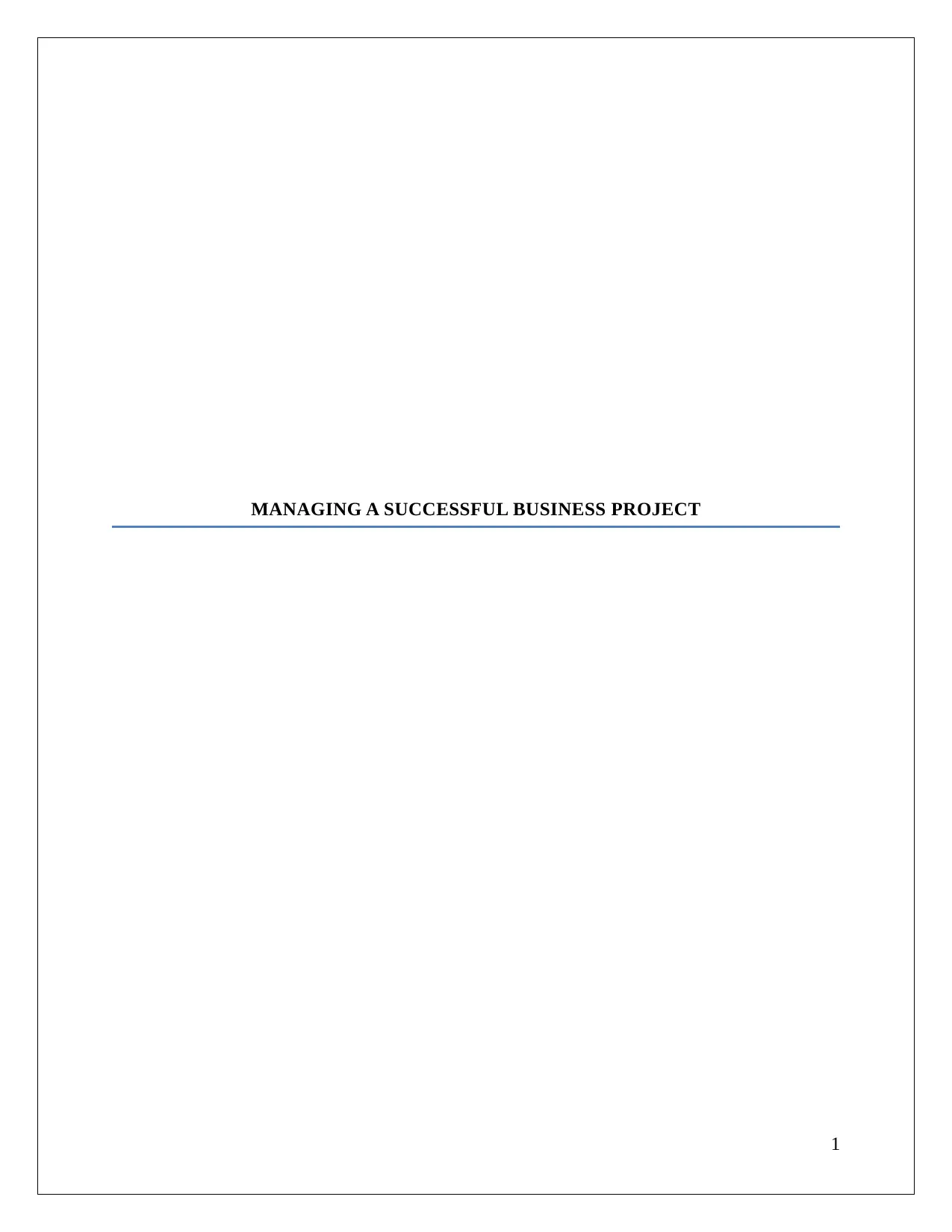
MANAGING A SUCCESSFUL BUSINESS PROJECT
1
1
Paraphrase This Document
Need a fresh take? Get an instant paraphrase of this document with our AI Paraphraser
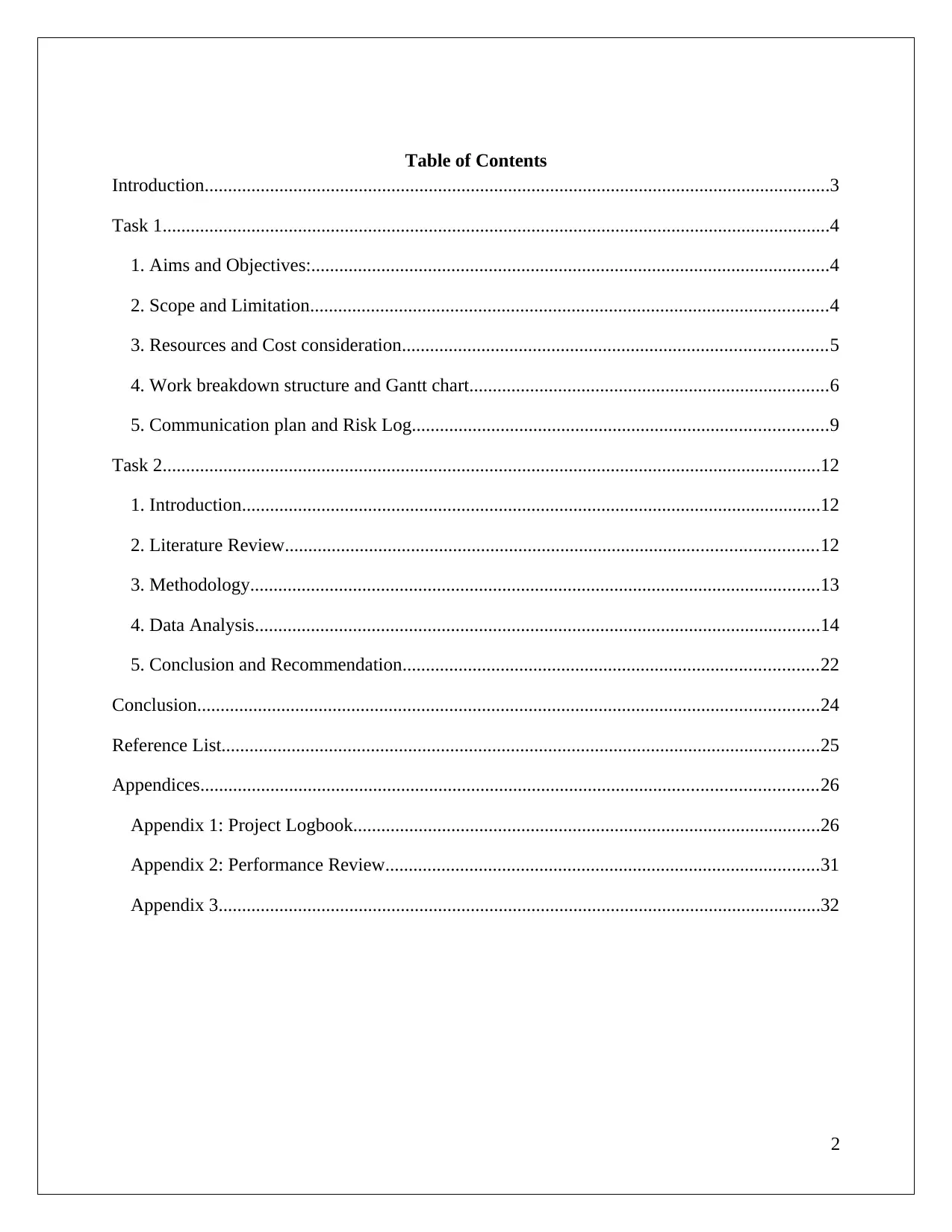
Table of Contents
Introduction......................................................................................................................................3
Task 1...............................................................................................................................................4
1. Aims and Objectives:...............................................................................................................4
2. Scope and Limitation...............................................................................................................4
3. Resources and Cost consideration...........................................................................................5
4. Work breakdown structure and Gantt chart.............................................................................6
5. Communication plan and Risk Log.........................................................................................9
Task 2.............................................................................................................................................12
1. Introduction............................................................................................................................12
2. Literature Review..................................................................................................................12
3. Methodology..........................................................................................................................13
4. Data Analysis.........................................................................................................................14
5. Conclusion and Recommendation.........................................................................................22
Conclusion.....................................................................................................................................24
Reference List................................................................................................................................25
Appendices....................................................................................................................................26
Appendix 1: Project Logbook....................................................................................................26
Appendix 2: Performance Review.............................................................................................31
Appendix 3.................................................................................................................................32
2
Introduction......................................................................................................................................3
Task 1...............................................................................................................................................4
1. Aims and Objectives:...............................................................................................................4
2. Scope and Limitation...............................................................................................................4
3. Resources and Cost consideration...........................................................................................5
4. Work breakdown structure and Gantt chart.............................................................................6
5. Communication plan and Risk Log.........................................................................................9
Task 2.............................................................................................................................................12
1. Introduction............................................................................................................................12
2. Literature Review..................................................................................................................12
3. Methodology..........................................................................................................................13
4. Data Analysis.........................................................................................................................14
5. Conclusion and Recommendation.........................................................................................22
Conclusion.....................................................................................................................................24
Reference List................................................................................................................................25
Appendices....................................................................................................................................26
Appendix 1: Project Logbook....................................................................................................26
Appendix 2: Performance Review.............................................................................................31
Appendix 3.................................................................................................................................32
2
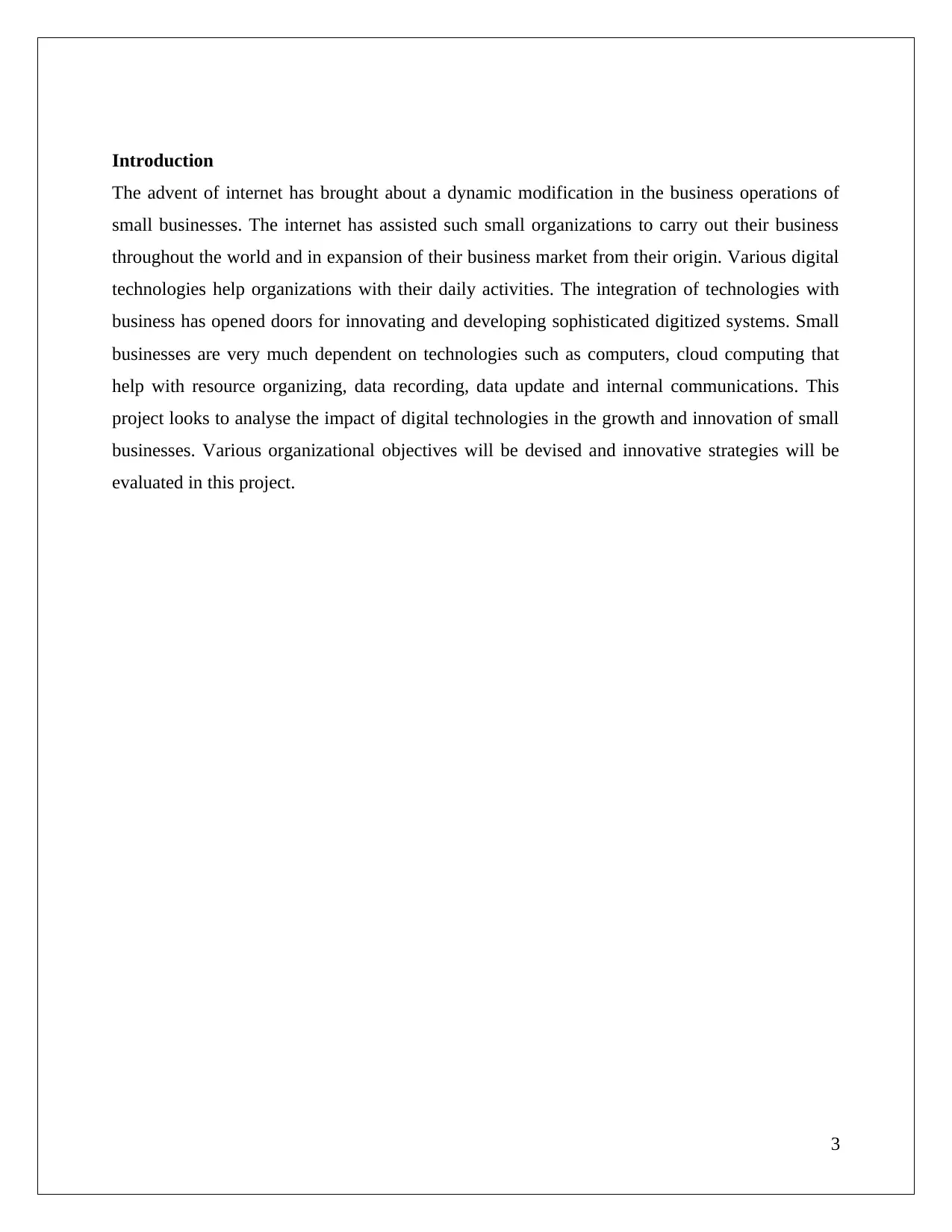
Introduction
The advent of internet has brought about a dynamic modification in the business operations of
small businesses. The internet has assisted such small organizations to carry out their business
throughout the world and in expansion of their business market from their origin. Various digital
technologies help organizations with their daily activities. The integration of technologies with
business has opened doors for innovating and developing sophisticated digitized systems. Small
businesses are very much dependent on technologies such as computers, cloud computing that
help with resource organizing, data recording, data update and internal communications. This
project looks to analyse the impact of digital technologies in the growth and innovation of small
businesses. Various organizational objectives will be devised and innovative strategies will be
evaluated in this project.
3
The advent of internet has brought about a dynamic modification in the business operations of
small businesses. The internet has assisted such small organizations to carry out their business
throughout the world and in expansion of their business market from their origin. Various digital
technologies help organizations with their daily activities. The integration of technologies with
business has opened doors for innovating and developing sophisticated digitized systems. Small
businesses are very much dependent on technologies such as computers, cloud computing that
help with resource organizing, data recording, data update and internal communications. This
project looks to analyse the impact of digital technologies in the growth and innovation of small
businesses. Various organizational objectives will be devised and innovative strategies will be
evaluated in this project.
3
⊘ This is a preview!⊘
Do you want full access?
Subscribe today to unlock all pages.

Trusted by 1+ million students worldwide
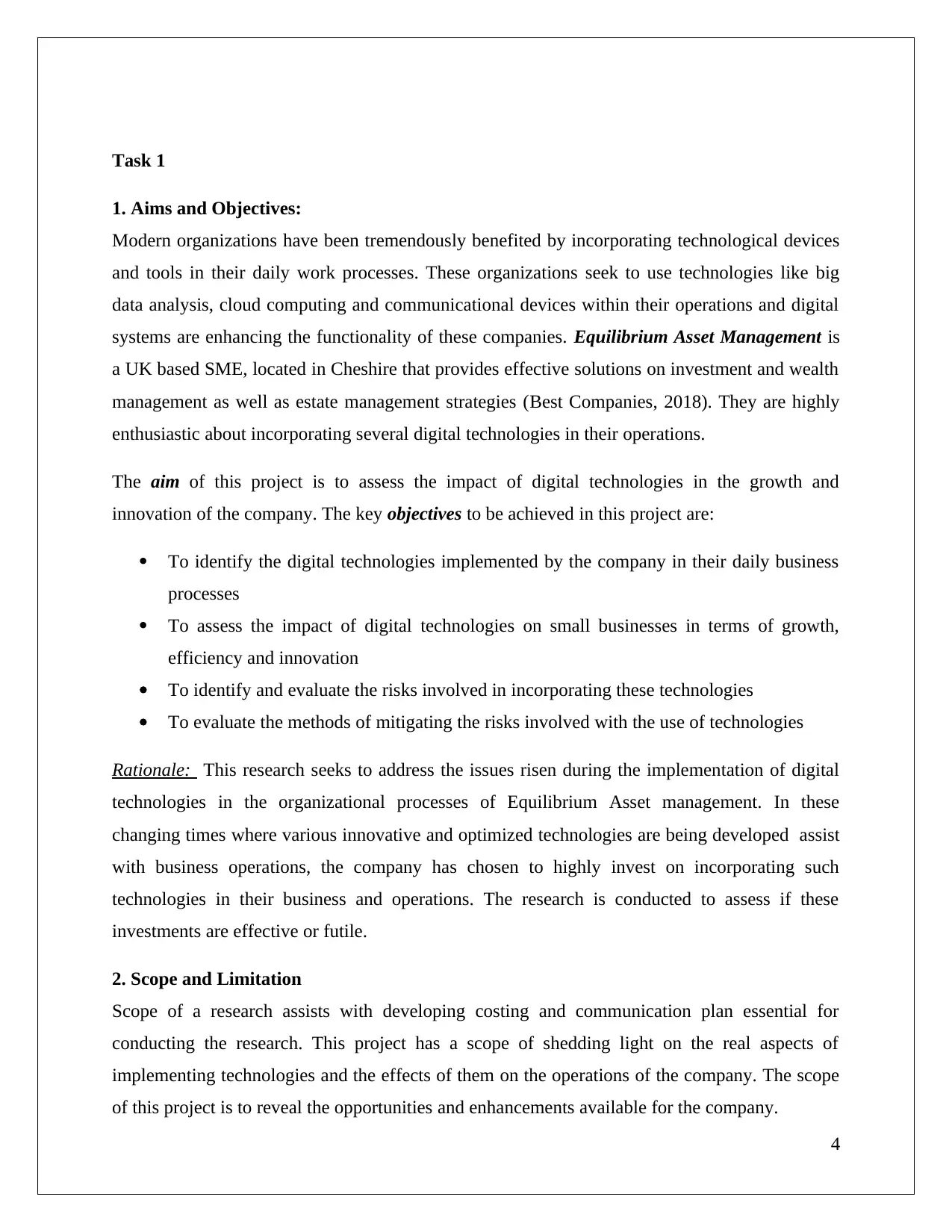
Task 1
1. Aims and Objectives:
Modern organizations have been tremendously benefited by incorporating technological devices
and tools in their daily work processes. These organizations seek to use technologies like big
data analysis, cloud computing and communicational devices within their operations and digital
systems are enhancing the functionality of these companies. Equilibrium Asset Management is
a UK based SME, located in Cheshire that provides effective solutions on investment and wealth
management as well as estate management strategies (Best Companies, 2018). They are highly
enthusiastic about incorporating several digital technologies in their operations.
The aim of this project is to assess the impact of digital technologies in the growth and
innovation of the company. The key objectives to be achieved in this project are:
To identify the digital technologies implemented by the company in their daily business
processes
To assess the impact of digital technologies on small businesses in terms of growth,
efficiency and innovation
To identify and evaluate the risks involved in incorporating these technologies
To evaluate the methods of mitigating the risks involved with the use of technologies
Rationale: This research seeks to address the issues risen during the implementation of digital
technologies in the organizational processes of Equilibrium Asset management. In these
changing times where various innovative and optimized technologies are being developed assist
with business operations, the company has chosen to highly invest on incorporating such
technologies in their business and operations. The research is conducted to assess if these
investments are effective or futile.
2. Scope and Limitation
Scope of a research assists with developing costing and communication plan essential for
conducting the research. This project has a scope of shedding light on the real aspects of
implementing technologies and the effects of them on the operations of the company. The scope
of this project is to reveal the opportunities and enhancements available for the company.
4
1. Aims and Objectives:
Modern organizations have been tremendously benefited by incorporating technological devices
and tools in their daily work processes. These organizations seek to use technologies like big
data analysis, cloud computing and communicational devices within their operations and digital
systems are enhancing the functionality of these companies. Equilibrium Asset Management is
a UK based SME, located in Cheshire that provides effective solutions on investment and wealth
management as well as estate management strategies (Best Companies, 2018). They are highly
enthusiastic about incorporating several digital technologies in their operations.
The aim of this project is to assess the impact of digital technologies in the growth and
innovation of the company. The key objectives to be achieved in this project are:
To identify the digital technologies implemented by the company in their daily business
processes
To assess the impact of digital technologies on small businesses in terms of growth,
efficiency and innovation
To identify and evaluate the risks involved in incorporating these technologies
To evaluate the methods of mitigating the risks involved with the use of technologies
Rationale: This research seeks to address the issues risen during the implementation of digital
technologies in the organizational processes of Equilibrium Asset management. In these
changing times where various innovative and optimized technologies are being developed assist
with business operations, the company has chosen to highly invest on incorporating such
technologies in their business and operations. The research is conducted to assess if these
investments are effective or futile.
2. Scope and Limitation
Scope of a research assists with developing costing and communication plan essential for
conducting the research. This project has a scope of shedding light on the real aspects of
implementing technologies and the effects of them on the operations of the company. The scope
of this project is to reveal the opportunities and enhancements available for the company.
4
Paraphrase This Document
Need a fresh take? Get an instant paraphrase of this document with our AI Paraphraser
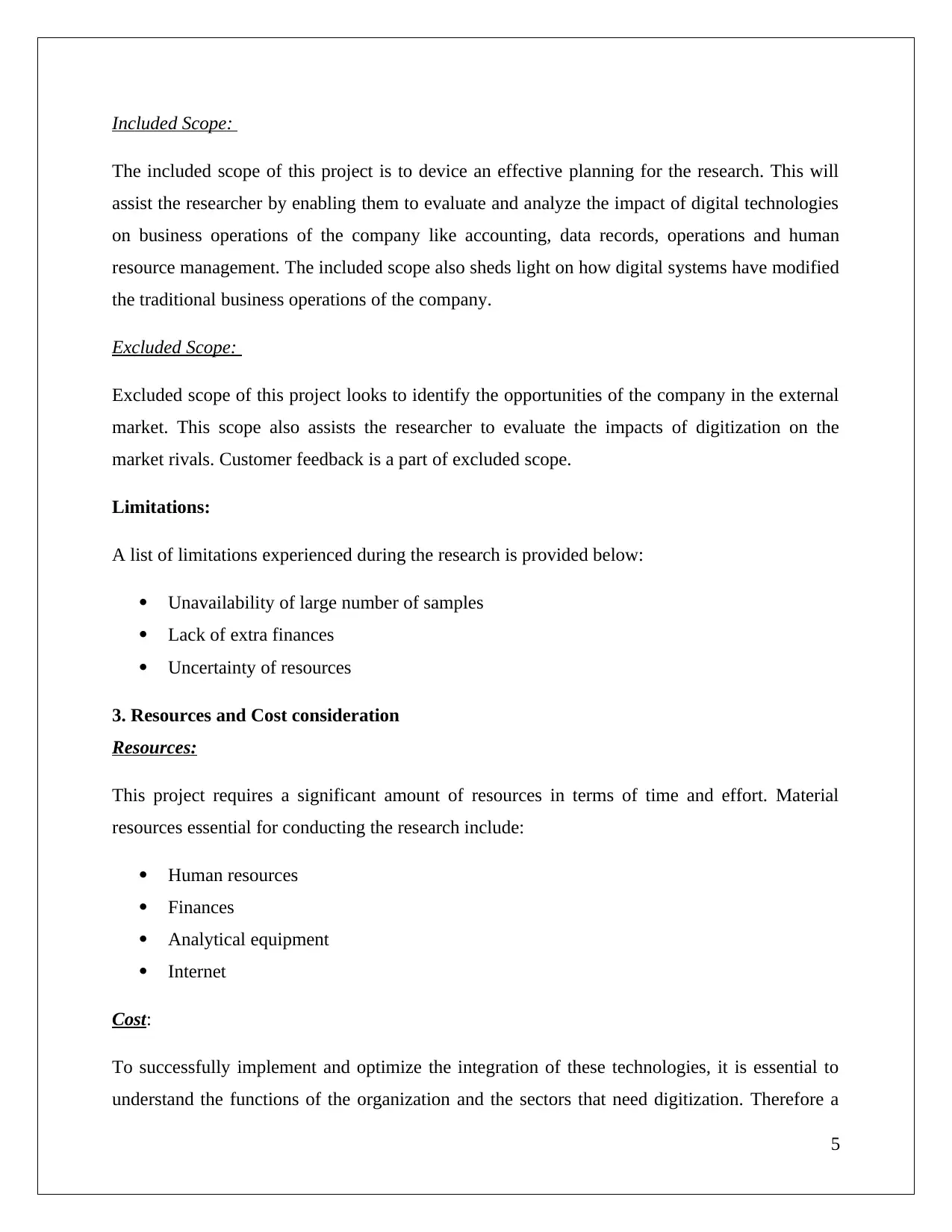
Included Scope:
The included scope of this project is to device an effective planning for the research. This will
assist the researcher by enabling them to evaluate and analyze the impact of digital technologies
on business operations of the company like accounting, data records, operations and human
resource management. The included scope also sheds light on how digital systems have modified
the traditional business operations of the company.
Excluded Scope:
Excluded scope of this project looks to identify the opportunities of the company in the external
market. This scope also assists the researcher to evaluate the impacts of digitization on the
market rivals. Customer feedback is a part of excluded scope.
Limitations:
A list of limitations experienced during the research is provided below:
Unavailability of large number of samples
Lack of extra finances
Uncertainty of resources
3. Resources and Cost consideration
Resources:
This project requires a significant amount of resources in terms of time and effort. Material
resources essential for conducting the research include:
Human resources
Finances
Analytical equipment
Internet
Cost:
To successfully implement and optimize the integration of these technologies, it is essential to
understand the functions of the organization and the sectors that need digitization. Therefore a
5
The included scope of this project is to device an effective planning for the research. This will
assist the researcher by enabling them to evaluate and analyze the impact of digital technologies
on business operations of the company like accounting, data records, operations and human
resource management. The included scope also sheds light on how digital systems have modified
the traditional business operations of the company.
Excluded Scope:
Excluded scope of this project looks to identify the opportunities of the company in the external
market. This scope also assists the researcher to evaluate the impacts of digitization on the
market rivals. Customer feedback is a part of excluded scope.
Limitations:
A list of limitations experienced during the research is provided below:
Unavailability of large number of samples
Lack of extra finances
Uncertainty of resources
3. Resources and Cost consideration
Resources:
This project requires a significant amount of resources in terms of time and effort. Material
resources essential for conducting the research include:
Human resources
Finances
Analytical equipment
Internet
Cost:
To successfully implement and optimize the integration of these technologies, it is essential to
understand the functions of the organization and the sectors that need digitization. Therefore a
5
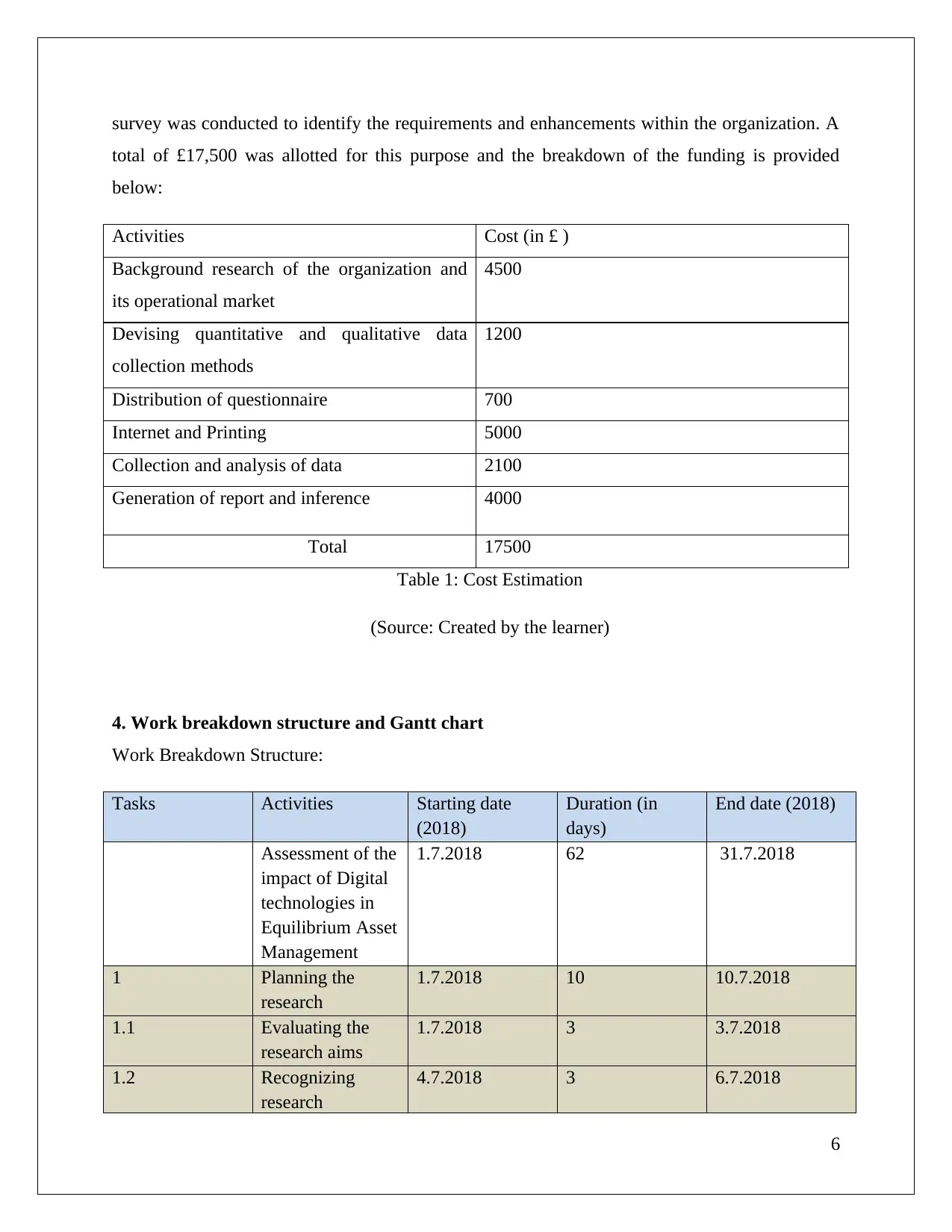
survey was conducted to identify the requirements and enhancements within the organization. A
total of £17,500 was allotted for this purpose and the breakdown of the funding is provided
below:
Activities Cost (in £ )
Background research of the organization and
its operational market
4500
Devising quantitative and qualitative data
collection methods
1200
Distribution of questionnaire 700
Internet and Printing 5000
Collection and analysis of data 2100
Generation of report and inference 4000
Total 17500
Table 1: Cost Estimation
(Source: Created by the learner)
4. Work breakdown structure and Gantt chart
Work Breakdown Structure:
Tasks Activities Starting date
(2018)
Duration (in
days)
End date (2018)
Assessment of the
impact of Digital
technologies in
Equilibrium Asset
Management
1.7.2018 62 31.7.2018
1 Planning the
research
1.7.2018 10 10.7.2018
1.1 Evaluating the
research aims
1.7.2018 3 3.7.2018
1.2 Recognizing
research
4.7.2018 3 6.7.2018
6
total of £17,500 was allotted for this purpose and the breakdown of the funding is provided
below:
Activities Cost (in £ )
Background research of the organization and
its operational market
4500
Devising quantitative and qualitative data
collection methods
1200
Distribution of questionnaire 700
Internet and Printing 5000
Collection and analysis of data 2100
Generation of report and inference 4000
Total 17500
Table 1: Cost Estimation
(Source: Created by the learner)
4. Work breakdown structure and Gantt chart
Work Breakdown Structure:
Tasks Activities Starting date
(2018)
Duration (in
days)
End date (2018)
Assessment of the
impact of Digital
technologies in
Equilibrium Asset
Management
1.7.2018 62 31.7.2018
1 Planning the
research
1.7.2018 10 10.7.2018
1.1 Evaluating the
research aims
1.7.2018 3 3.7.2018
1.2 Recognizing
research
4.7.2018 3 6.7.2018
6
⊘ This is a preview!⊘
Do you want full access?
Subscribe today to unlock all pages.

Trusted by 1+ million students worldwide
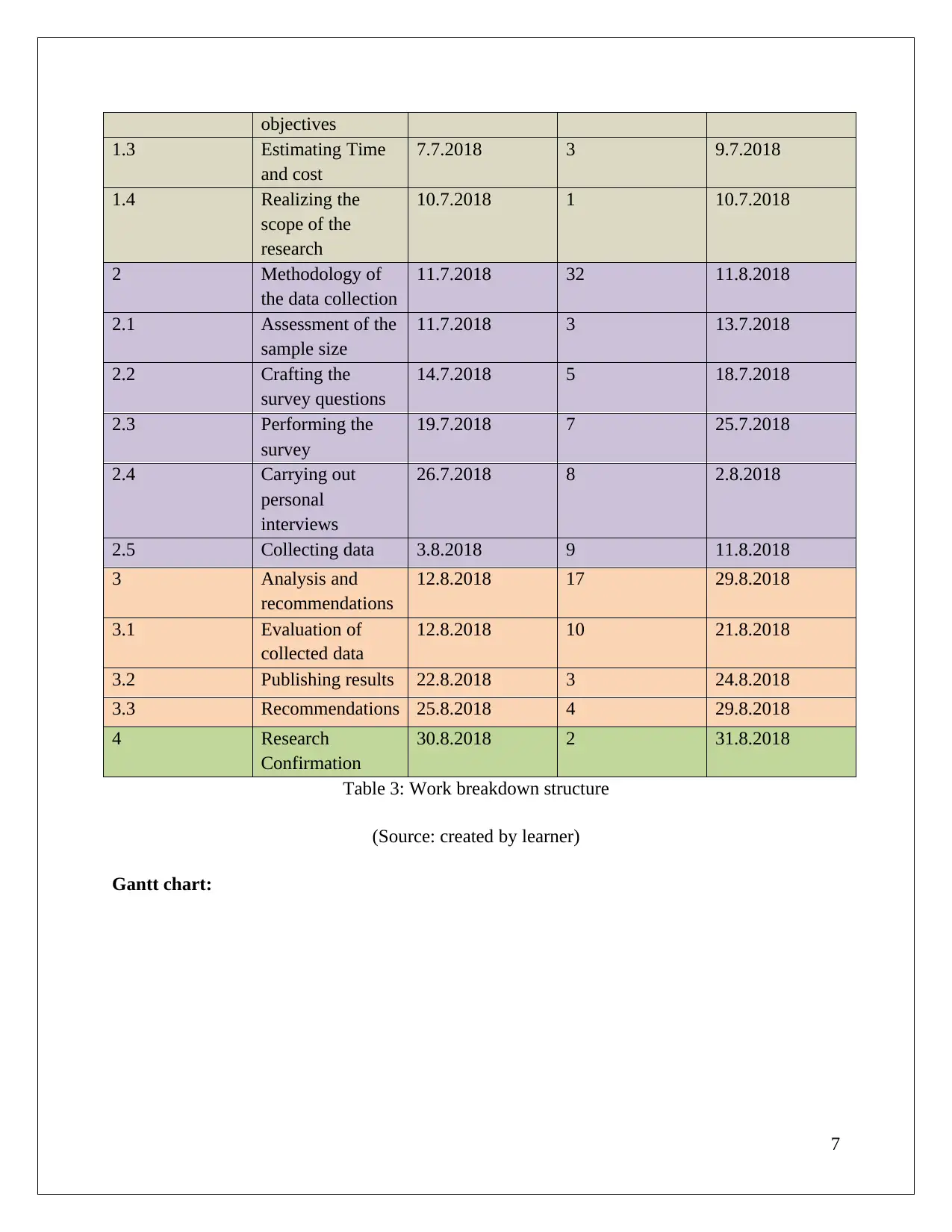
objectives
1.3 Estimating Time
and cost
7.7.2018 3 9.7.2018
1.4 Realizing the
scope of the
research
10.7.2018 1 10.7.2018
2 Methodology of
the data collection
11.7.2018 32 11.8.2018
2.1 Assessment of the
sample size
11.7.2018 3 13.7.2018
2.2 Crafting the
survey questions
14.7.2018 5 18.7.2018
2.3 Performing the
survey
19.7.2018 7 25.7.2018
2.4 Carrying out
personal
interviews
26.7.2018 8 2.8.2018
2.5 Collecting data 3.8.2018 9 11.8.2018
3 Analysis and
recommendations
12.8.2018 17 29.8.2018
3.1 Evaluation of
collected data
12.8.2018 10 21.8.2018
3.2 Publishing results 22.8.2018 3 24.8.2018
3.3 Recommendations 25.8.2018 4 29.8.2018
4 Research
Confirmation
30.8.2018 2 31.8.2018
Table 3: Work breakdown structure
(Source: created by learner)
Gantt chart:
7
1.3 Estimating Time
and cost
7.7.2018 3 9.7.2018
1.4 Realizing the
scope of the
research
10.7.2018 1 10.7.2018
2 Methodology of
the data collection
11.7.2018 32 11.8.2018
2.1 Assessment of the
sample size
11.7.2018 3 13.7.2018
2.2 Crafting the
survey questions
14.7.2018 5 18.7.2018
2.3 Performing the
survey
19.7.2018 7 25.7.2018
2.4 Carrying out
personal
interviews
26.7.2018 8 2.8.2018
2.5 Collecting data 3.8.2018 9 11.8.2018
3 Analysis and
recommendations
12.8.2018 17 29.8.2018
3.1 Evaluation of
collected data
12.8.2018 10 21.8.2018
3.2 Publishing results 22.8.2018 3 24.8.2018
3.3 Recommendations 25.8.2018 4 29.8.2018
4 Research
Confirmation
30.8.2018 2 31.8.2018
Table 3: Work breakdown structure
(Source: created by learner)
Gantt chart:
7
Paraphrase This Document
Need a fresh take? Get an instant paraphrase of this document with our AI Paraphraser
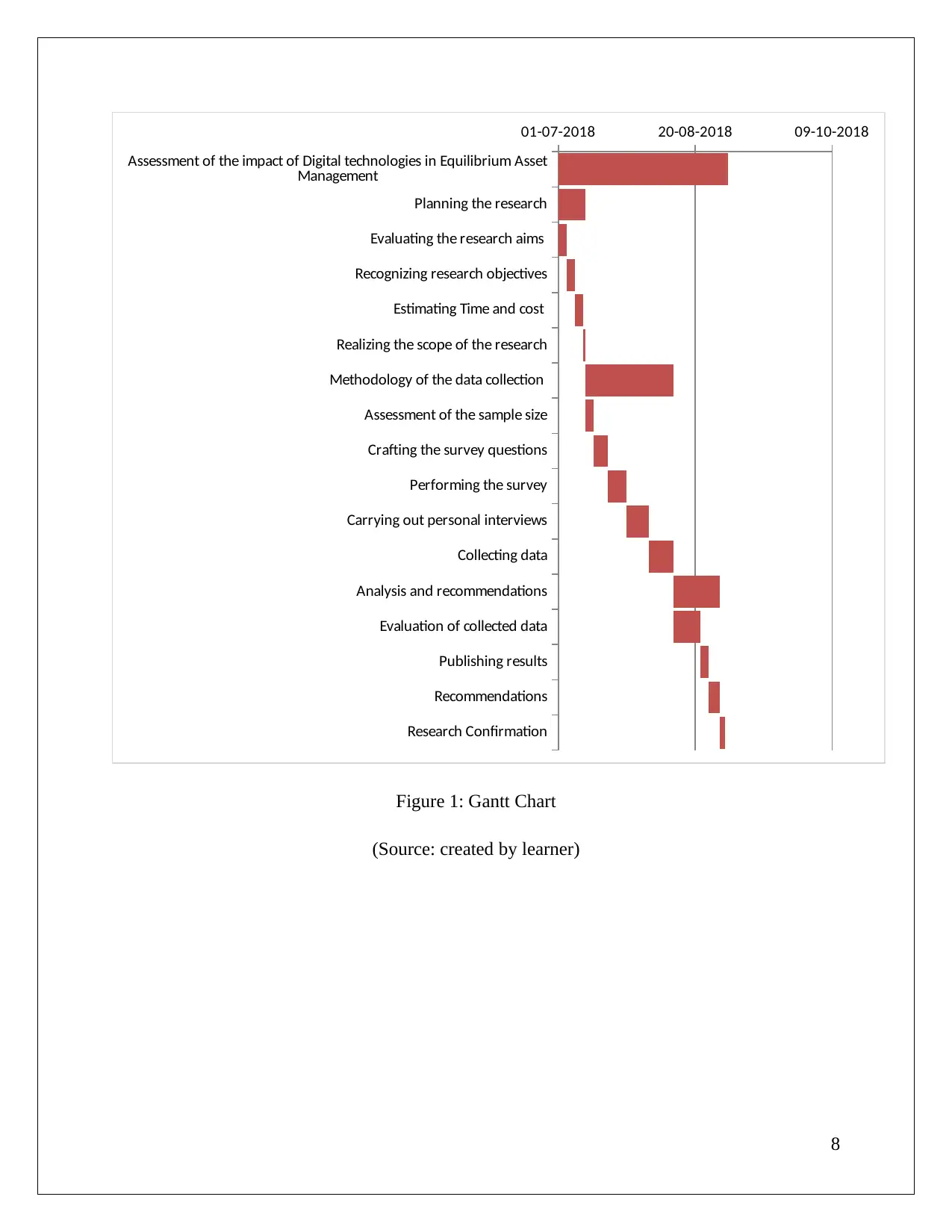
Assessment of the impact of Digital technologies in Equilibrium Asset
Management
Planning the research
Evaluating the research aims
Recognizing research objectives
Estimating Time and cost
Realizing the scope of the research
Methodology of the data collection
Assessment of the sample size
Crafting the survey questions
Performing the survey
Carrying out personal interviews
Collecting data
Analysis and recommendations
Evaluation of collected data
Publishing results
Recommendations
Research Confirmation
01-07-2018 20-08-2018 09-10-2018
Figure 1: Gantt Chart
(Source: created by learner)
8
Management
Planning the research
Evaluating the research aims
Recognizing research objectives
Estimating Time and cost
Realizing the scope of the research
Methodology of the data collection
Assessment of the sample size
Crafting the survey questions
Performing the survey
Carrying out personal interviews
Collecting data
Analysis and recommendations
Evaluation of collected data
Publishing results
Recommendations
Research Confirmation
01-07-2018 20-08-2018 09-10-2018
Figure 1: Gantt Chart
(Source: created by learner)
8
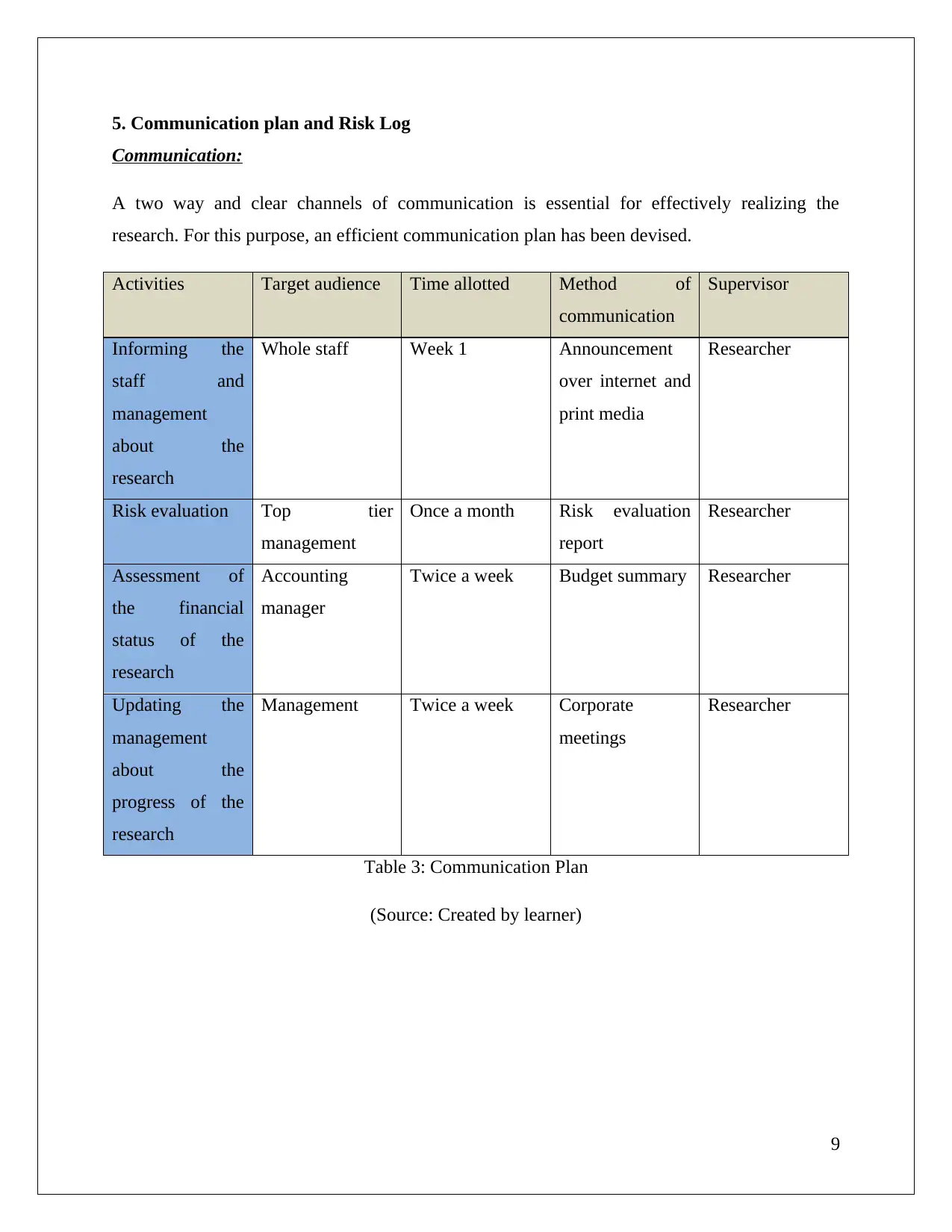
5. Communication plan and Risk Log
Communication:
A two way and clear channels of communication is essential for effectively realizing the
research. For this purpose, an efficient communication plan has been devised.
Activities Target audience Time allotted Method of
communication
Supervisor
Informing the
staff and
management
about the
research
Whole staff Week 1 Announcement
over internet and
print media
Researcher
Risk evaluation Top tier
management
Once a month Risk evaluation
report
Researcher
Assessment of
the financial
status of the
research
Accounting
manager
Twice a week Budget summary Researcher
Updating the
management
about the
progress of the
research
Management Twice a week Corporate
meetings
Researcher
Table 3: Communication Plan
(Source: Created by learner)
9
Communication:
A two way and clear channels of communication is essential for effectively realizing the
research. For this purpose, an efficient communication plan has been devised.
Activities Target audience Time allotted Method of
communication
Supervisor
Informing the
staff and
management
about the
research
Whole staff Week 1 Announcement
over internet and
print media
Researcher
Risk evaluation Top tier
management
Once a month Risk evaluation
report
Researcher
Assessment of
the financial
status of the
research
Accounting
manager
Twice a week Budget summary Researcher
Updating the
management
about the
progress of the
research
Management Twice a week Corporate
meetings
Researcher
Table 3: Communication Plan
(Source: Created by learner)
9
⊘ This is a preview!⊘
Do you want full access?
Subscribe today to unlock all pages.

Trusted by 1+ million students worldwide
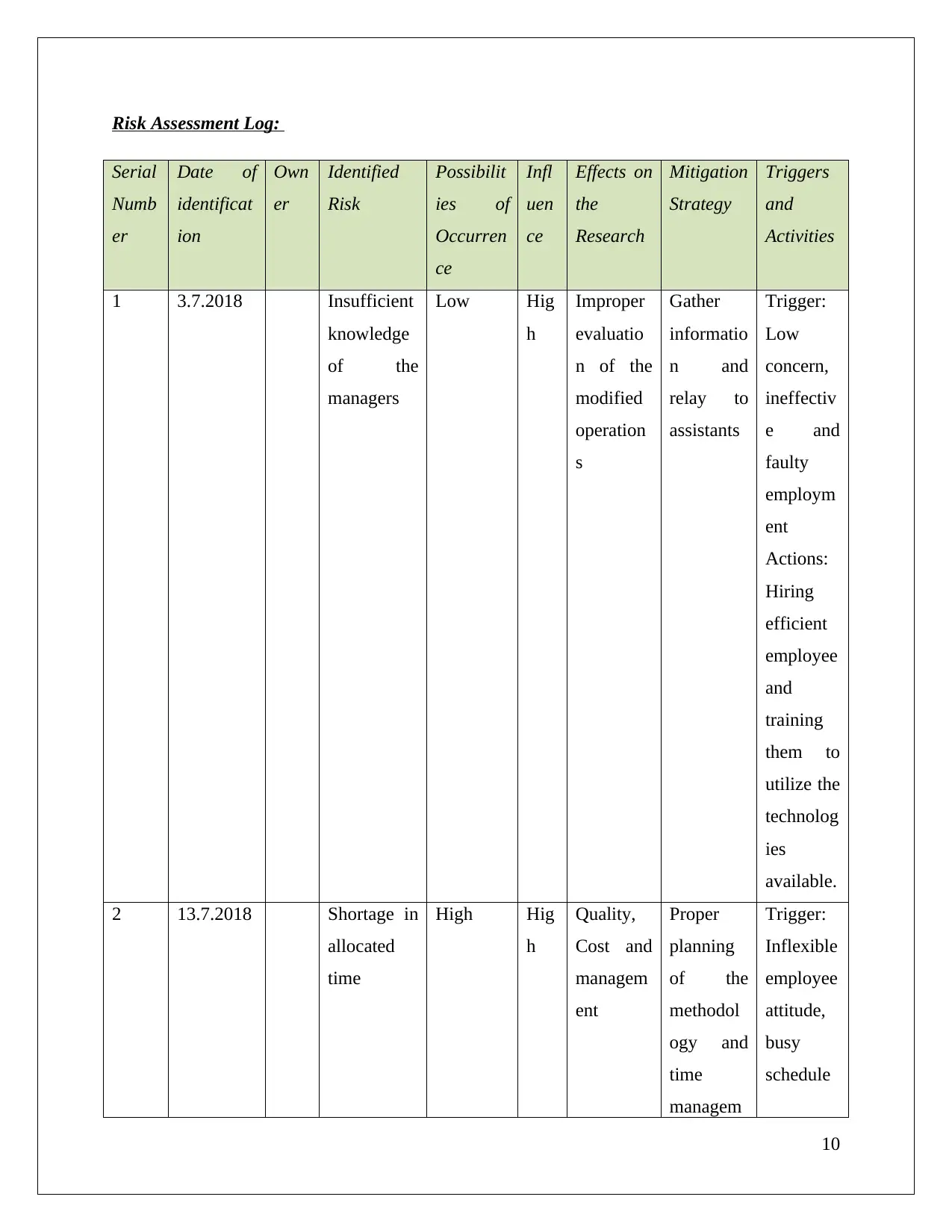
Risk Assessment Log:
Serial
Numb
er
Date of
identificat
ion
Own
er
Identified
Risk
Possibilit
ies of
Occurren
ce
Infl
uen
ce
Effects on
the
Research
Mitigation
Strategy
Triggers
and
Activities
1 3.7.2018 Insufficient
knowledge
of the
managers
Low Hig
h
Improper
evaluatio
n of the
modified
operation
s
Gather
informatio
n and
relay to
assistants
Trigger:
Low
concern,
ineffectiv
e and
faulty
employm
ent
Actions:
Hiring
efficient
employee
and
training
them to
utilize the
technolog
ies
available.
2 13.7.2018 Shortage in
allocated
time
High Hig
h
Quality,
Cost and
managem
ent
Proper
planning
of the
methodol
ogy and
time
managem
Trigger:
Inflexible
employee
attitude,
busy
schedule
10
Serial
Numb
er
Date of
identificat
ion
Own
er
Identified
Risk
Possibilit
ies of
Occurren
ce
Infl
uen
ce
Effects on
the
Research
Mitigation
Strategy
Triggers
and
Activities
1 3.7.2018 Insufficient
knowledge
of the
managers
Low Hig
h
Improper
evaluatio
n of the
modified
operation
s
Gather
informatio
n and
relay to
assistants
Trigger:
Low
concern,
ineffectiv
e and
faulty
employm
ent
Actions:
Hiring
efficient
employee
and
training
them to
utilize the
technolog
ies
available.
2 13.7.2018 Shortage in
allocated
time
High Hig
h
Quality,
Cost and
managem
ent
Proper
planning
of the
methodol
ogy and
time
managem
Trigger:
Inflexible
employee
attitude,
busy
schedule
10
Paraphrase This Document
Need a fresh take? Get an instant paraphrase of this document with our AI Paraphraser
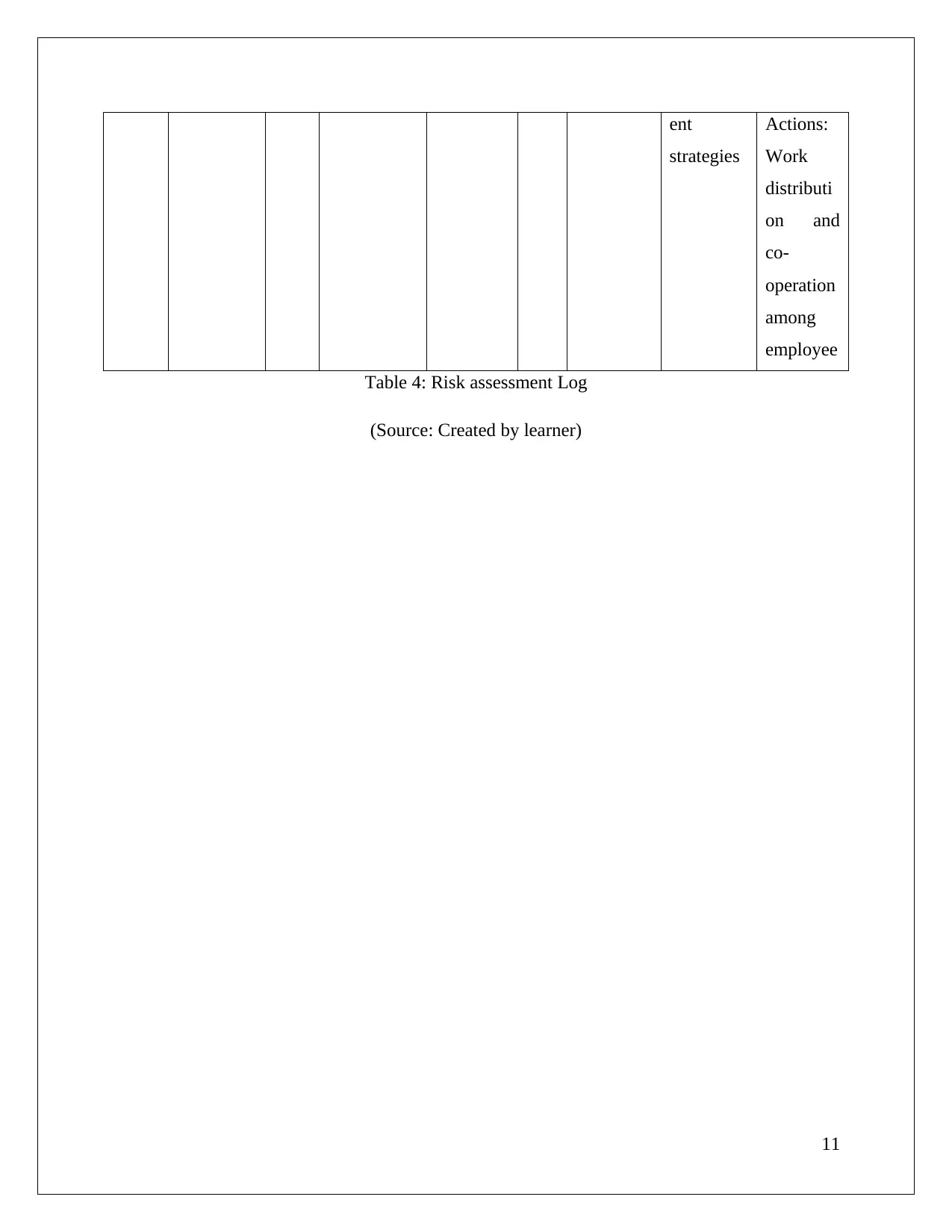
ent
strategies
Actions:
Work
distributi
on and
co-
operation
among
employee
Table 4: Risk assessment Log
(Source: Created by learner)
11
strategies
Actions:
Work
distributi
on and
co-
operation
among
employee
Table 4: Risk assessment Log
(Source: Created by learner)
11
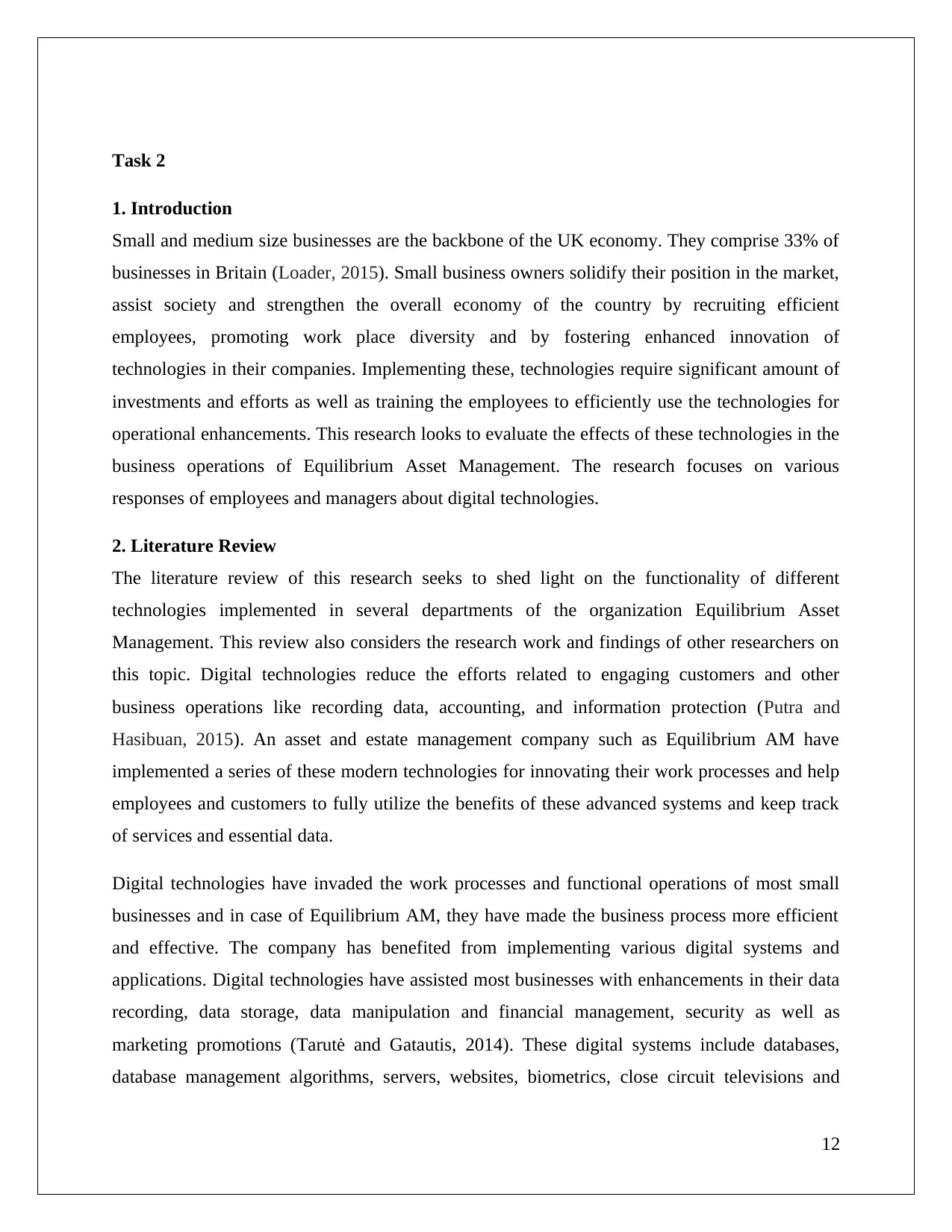
Task 2
1. Introduction
Small and medium size businesses are the backbone of the UK economy. They comprise 33% of
businesses in Britain (Loader, 2015). Small business owners solidify their position in the market,
assist society and strengthen the overall economy of the country by recruiting efficient
employees, promoting work place diversity and by fostering enhanced innovation of
technologies in their companies. Implementing these, technologies require significant amount of
investments and efforts as well as training the employees to efficiently use the technologies for
operational enhancements. This research looks to evaluate the effects of these technologies in the
business operations of Equilibrium Asset Management. The research focuses on various
responses of employees and managers about digital technologies.
2. Literature Review
The literature review of this research seeks to shed light on the functionality of different
technologies implemented in several departments of the organization Equilibrium Asset
Management. This review also considers the research work and findings of other researchers on
this topic. Digital technologies reduce the efforts related to engaging customers and other
business operations like recording data, accounting, and information protection (Putra and
Hasibuan, 2015). An asset and estate management company such as Equilibrium AM have
implemented a series of these modern technologies for innovating their work processes and help
employees and customers to fully utilize the benefits of these advanced systems and keep track
of services and essential data.
Digital technologies have invaded the work processes and functional operations of most small
businesses and in case of Equilibrium AM, they have made the business process more efficient
and effective. The company has benefited from implementing various digital systems and
applications. Digital technologies have assisted most businesses with enhancements in their data
recording, data storage, data manipulation and financial management, security as well as
marketing promotions (Tarutė and Gatautis, 2014). These digital systems include databases,
database management algorithms, servers, websites, biometrics, close circuit televisions and
12
1. Introduction
Small and medium size businesses are the backbone of the UK economy. They comprise 33% of
businesses in Britain (Loader, 2015). Small business owners solidify their position in the market,
assist society and strengthen the overall economy of the country by recruiting efficient
employees, promoting work place diversity and by fostering enhanced innovation of
technologies in their companies. Implementing these, technologies require significant amount of
investments and efforts as well as training the employees to efficiently use the technologies for
operational enhancements. This research looks to evaluate the effects of these technologies in the
business operations of Equilibrium Asset Management. The research focuses on various
responses of employees and managers about digital technologies.
2. Literature Review
The literature review of this research seeks to shed light on the functionality of different
technologies implemented in several departments of the organization Equilibrium Asset
Management. This review also considers the research work and findings of other researchers on
this topic. Digital technologies reduce the efforts related to engaging customers and other
business operations like recording data, accounting, and information protection (Putra and
Hasibuan, 2015). An asset and estate management company such as Equilibrium AM have
implemented a series of these modern technologies for innovating their work processes and help
employees and customers to fully utilize the benefits of these advanced systems and keep track
of services and essential data.
Digital technologies have invaded the work processes and functional operations of most small
businesses and in case of Equilibrium AM, they have made the business process more efficient
and effective. The company has benefited from implementing various digital systems and
applications. Digital technologies have assisted most businesses with enhancements in their data
recording, data storage, data manipulation and financial management, security as well as
marketing promotions (Tarutė and Gatautis, 2014). These digital systems include databases,
database management algorithms, servers, websites, biometrics, close circuit televisions and
12
⊘ This is a preview!⊘
Do you want full access?
Subscribe today to unlock all pages.

Trusted by 1+ million students worldwide
1 out of 34
Related Documents
Your All-in-One AI-Powered Toolkit for Academic Success.
+13062052269
info@desklib.com
Available 24*7 on WhatsApp / Email
![[object Object]](/_next/static/media/star-bottom.7253800d.svg)
Unlock your academic potential
Copyright © 2020–2025 A2Z Services. All Rights Reserved. Developed and managed by ZUCOL.





